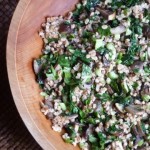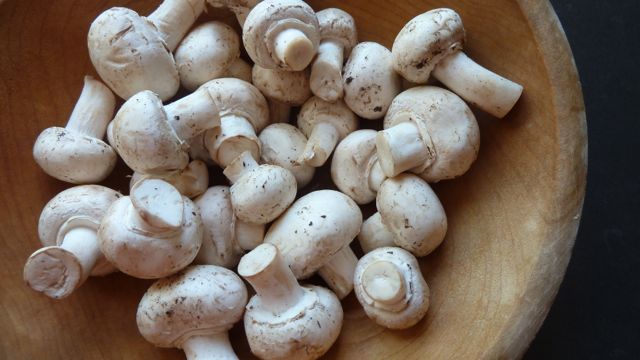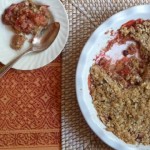Mushrooms have an air of magical mystery about them. Ever notice how wild ones appear, as if out of nowhere, in the moist, loamy dirt—like pillowy perches conjured up by a weary garden sprite? In the kitchen they can be equally enchanting—taste-wise and nutritionally, too. Recent studies are showing evidence that the ordinary button variety is loaded with health benefits (in some cases surpassing that of their more exotic brethren like shitake)—regulating inflammation, protecting against cardiovascular disease, estrogen-fueled breast cancers and more. They are also an excellent source of selenium, Vitamins B2, B3 and B5, copper, potassium and phosphorus.
It’s important to store mushrooms properly to preserve their nutritional content. Keep them in a paper bag (versus plastic) in the refrigerator. This allows for good air circulation, while retaining moisture content. Clean mushrooms at the point you plan to use them. Wipe with a damp cloth to remove grit. You can spray lightly with water to aid in the process.
Commercially produced mushrooms are cultivated through a multistep process. A substrate is created with composted material as a growing medium; next mushroom spores are germinated and added to the compost where they propagate into colonies (called spawning). The last phases involve adding an additional layer of “casing”—a soil and compost mixture—which triggers “pinning”—the fruiting stage that produces the recognizable button cap shape. It’s important to eat organically produced mushrooms which hold to high standards in the quality of compost used throughout the process.
Mushrooms are the rare non-meat food that take on some of the properties of meat when cooked. If you’ve ever eaten a marinated and grilled portobello cap you’ll know what I mean. They have a firm, but juicy texture and a deep flavoring that feels just right on the tongue—an intangible something that’s simply delicious called umani. The word umani comes from the Japanese for “pleasant savory taste”, and it describes a particular sensation on the tongue that is long-lasting, mouthwatering and supremely pleasant—some would call meaty. It is detected by specific receptor cells, and is one of the five basic tastes detectable by the tongue, including sweet, salty, bitter and sour. Mushrooms are among a small group of foods that produce this particularly delightful taste bud experience. Lucky we have some tucked into our deliveries this week. Enjoy.
Recipes for the Week:
Try this creamy mushroom soup—perfect for these last few days of cool weather before summer hits in full force.
 Barley Salad with Roasted Mushrooms and Greens
Barley Salad with Roasted Mushrooms and Greens
Roasted mushrooms and crisp chard add loads of flavor to this hearty grain salad. Substitute cooked brown rice, nutty farro or any other favorite grain for the barley.
 Mexican Rice with Zucchini, Corn and Tomatoes
Mexican Rice with Zucchini, Corn and Tomatoes
This easy side dish is perfect when you have leftover rice from a previous night’s dinner—plus it’s a great way to showcase the fresh bounty of early summer.
If you happen to still have the rhubarb from last week, there’s no finer use than an old-fashioned American crisp—fresh out of the oven and topped with vanilla ice cream.
Quick Tips:
Steam or grill peeled corn ears. Cut kernels off the cob. Place in a bowl and toss with chopped arugula, sliced red onion and a vinaigrette made with apple cider vinegar.
Tomatoes and avocados in the same week? What else could we think but guacamole? All you need is a little chopped onion and fresh lime juice. Try cutting the avocados into cubes, instead of mashing. And add some fresh corn, too, for an unexpected crunch.
Chop parsley and arugula. Toss with olive oil and lemon juice and cooked couscous (any size). Add diced tomatoes and salt and freshly ground pepper. Maybe a few chunks of feta cheese, a bit of diced onion or salty black olives.
Sauté sliced mushrooms with pressed garlic (or minced onion) and butter. Beat a few Glaum eggs and pour over the top. Cook slowly over low heat, stirring to keep the eggs soft. Serve on toasted bread from Esther’s bakery. Add some chopped chard leaves to the mix, or fresh parsley and diced tomato. The variations are nearly endless. Eggs are a great way to start the day for young (or older) minds—robust brain-fueling food.
Roast those tomatoes. A great trick for the dull winter ones, and even better with an early summer specimen. Cut tomatoes into quarters or large pieces. Coat with olive oil, place skin-side down on a baking sheet and roast at 375 degrees for about 40 minutes, or until the skins show signs of brown, caramelized goodness. Serve with cooked pasta and fresh grated Parmesan cheese or on toasted baguette with some fresh parsley and a drizzle of olive oil or balsamic vinegar.





Glad you liked them! And thanks for the tip on how to use them. You’ll see more in your bag in coming weeks.